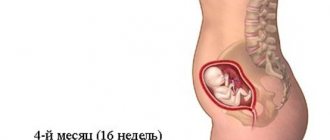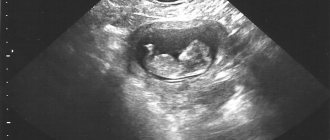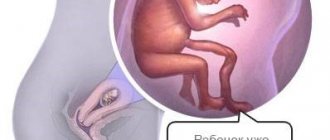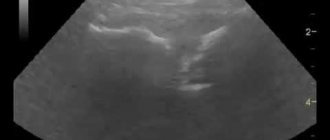The 36th week of pregnancy is considered the beginning of the last month in the development of the fetus, its intrauterine life. At this time the following are determined:
- Height;
- Baby's weight;
- Condition of the placenta;
- Condition of the uterus;
- Localization of the umbilical cord;
- Fetal presentation.
Having received all the necessary information, the obstetrician-gynecologist will determine the course of the upcoming birth and take care to avoid any deviations from the norm.
Condition of the expectant mother
The baby is quite active at this stage of pregnancy. He reminds his mother of himself almost 10 times in 12 hours. The baby's blows, now more constrained due to his considerable size, but at the same time stronger. They sometimes bring painful sensations to a pregnant woman.
During pregnancy, by the 36th week, a woman can gain up to 13 kg. By the time of birth, about 2 - 3 kilos will be added. A pregnant woman becomes overweight due to the added weight and growing belly. It becomes more difficult for her to move, and a feeling of clumsiness appears.
Most women experience increased swelling of their legs during this period of pregnancy. This change is explained by compression of the veins in the pelvis by the enlarged uterus.
By the 36th week, the expectant mother is increasingly worried about new painful sensations. They arise for many reasons:
- Child growth, uterine enlargement;
- Pressure of the uterus on the internal organs;
- Relaxation of ligaments and joints with special enzymes that the pregnant woman’s body secretes in preparation for childbirth;
- The expansion of the pelvic bones is accompanied by discomfort in the pelvic area and pubis.
In some cases, hemorrhoids occur, which also causes pain and discomfort. Pregnant women also experience lower back pain, heartburn, and breathing problems. The urge to go to the toilet has gradually become quite frequent and causes some inconvenience.
By the 36th week of pregnancy, the expectant mother's discharge may become more abundant than before. From this period, the mucous plug begins to move away, which was the reason for such a large amount of discharge. Normally they are colorless. If pinkish spots appear, this may indicate an imminent birth.
If cloudy mucus, pus is released, and itching is also felt, you need to be tested for the presence of infection, determine its origin, nature and select an effective, gentle treatment.
Pain in the lower abdomen accompanied by bloody discharge indicates placental abruption. The woman needs hospitalization and an unscheduled ultrasound.
Yellowish or transparent discharge with a watery consistency indicates the discharge of amniotic fluid.
False contractions become more frequent by the 36th week of pregnancy. To distinguish these contractions (Braxton-Higgs) from real ones, a woman must be prepared.
The belly has already become very large. Some women develop stretch marks; special emollients should be used to prevent stretching of the skin.
Week 36 is the time to visit the antenatal clinic for examinations, testing for AIDS and syphilis. The obstetrician also determines the abdominal circumference, checks the woman’s blood pressure, and examines the state of the microflora inside the birth canal.
Some useful tips
- If you have difficulty breathing, you need to get on all fours, inhale deeply and exhale slowly. Usually after this it becomes easier to breathe, since the fetus puts less pressure on the lungs. If you begin to feel worse, feel dizzy, or even have a nosebleed, consult a doctor immediately.
- If you're finding it increasingly difficult to fall asleep at night, there are a few ways you can relax and unwind before bed. Try not to drink a lot of liquid at night, not to spend the whole day on the couch, listen to relaxing music in the evening, you can even ask your loved one for a relaxing massage.
- During the third stage of pregnancy, your water begins to break. If you notice this process in yourself, then call an ambulance and go under the supervision of specialists, labor is about to begin.
And finally: avoid stressful situations, do not lift weights, eat only natural food. If necessary, your doctor will prescribe a complex of vitamins for pregnant women. In addition to nutrition, you can attend special courses for pregnant women. There you can learn many nuances about childbirth from specialists, communicate with other women, exchange observations and experiences.
Ultrasound indicators
When performing an ultrasound examination prescribed at the 36th week of pregnancy, the sonologist determines whether the following indicators correspond to the norm:
- The placenta has a second or third degree of maturity;
- The fetal position should normally be cephalic;
- The pharynx of the uterus (internal, external) should be closed;
- The amniotic fluid index is normally – 77 – 250;
- There should be 3 vessels inside the umbilical cord;
- The cervix is more than 3 cm long;
- The placenta has a thickness of 28–45 mm.
The following physiological parameters of the child are subject to measurement during an ultrasound:
- Baby’s height is 48 – 52 cm;
- Fetal abdominal circumference – 29 – 35 cm;
- Weight – normal 2,700 – 2,900 g;
- Tummy circumference – 29 – 35 cm;
- Normal fronto-occipital size is 105 – 125;
- Hip circumference should be approximately 65 - 75 cm;
- The lungs already have a second degree of maturity;
- The biparietal size normally reaches – 83 – 97 mm.
The specialist also determines the size of the baby’s bones using an ultrasound:
- Forearm – 50 – 58 cm;
- Shoulder – 57 – 67 cm;
- Shin – 58 – 66 cm;
- Thigh – 64 – 74.
Fetal development at 36 weeks of pregnancy - what will an ultrasound show?
An ultrasound at 36 weeks of pregnancy is intended to study the development of the fetus, the condition of its organs and systems. The formation of a child is coming to an end; almost all parts of his body are ready for birth. The skin and subcutaneous tissue function fully, therefore, they can protect the body from damage.
The weight of the fetus at this stage is more than 2.5 kg (with twins, the babies individually can weigh an order of magnitude less). The child looks like a newborn, which is especially clearly visible from 3D ultrasound. The child's height is about 47 cm, but maybe a little less. However, pregnancy is still developing, the functioning of organs is improving. This especially applies to the following systems:
- Endocrine.
- Nervous.
- Immune.
Iron accumulates in the liver, which will then take part in hematopoiesis. The heart rate is about 110-160 beats per minute. The lungs are still forming, but clumping of the alveoli is already being prevented due to the baby’s body producing the surfactant enzyme. However, at birth, the baby may need help from doctors to start breathing normally.
The development of the fetus at the 36th week of pregnancy is not complete in some of the skull bones, although they will remain soft until birth. This is necessary for the normal passage of the baby through the birth canal. The fontanelles do not close, so the bones of the skull can easily move during childbirth, reducing the size of the head.
The position of the baby at 36 weeks of pregnancy (ultrasound will show this) is cephalic, which is ideal before childbirth, or pelvic, which often allows for a natural birth. The presentation may also be breech, in which case the doctor will consider delivery via cesarean section.
An ultrasound picture at this stage can make it possible to see the sex of the child, because his movements are still active, therefore, there is a chance to see the genitals from the photo. But sometimes determining gender is difficult, especially if the child is large. The baby moves his legs, arms, and can suck a finger - the sucking reflex has long been developed.
Belly size
The abdomen usually grows to a very large size. As a result, stretching may occur. But sometimes there are quite small bellies. This size may cause concern to the obstetrician-gynecologist. A small belly may indicate a pathology such as oligohydramnios.
A small belly size may be a result of the baby's low weight. The reason may also be the peculiarity of the physique of a pregnant woman. If during an ultrasound the specialist did not find any pathologies in the expectant mother, then there is no need to worry too much.
By the 36th week of pregnancy, all women experience abdominal drooping. The reason is the descent of the fetus towards the birth canal; by this time, its head rests on the pelvic floor. Pain in the lower abdomen will indicate that labor is approaching. After lowering the abdomen, some relief is noted: the disappearance of heartburn, breathing becomes easier, all thanks to a decrease in the pressure of the uterus.
At 36 weeks, it is better to use the support of a special prenatal bandage; it makes the last weeks of pregnancy easier.
Ultrasound at 36 weeks of pregnancy - how is it done?
To prepare for the procedure, your doctor may recommend taking medications to reduce gas formation. This is necessary, but not for all pregnant women, but only if indicated. Otherwise, a woman only needs to maintain proper hygiene, take a napkin and the necessary documents, the results of previous ultrasounds.
The examination at this time involves a transabdominal ultrasound. It is performed while lying on your back or side. A special gel will be applied to the abdomen, after which a sensor will be moved over it. After diagnosis or during it, a research protocol is drawn up. It is given to the woman and filed with her medical record.
The price for an ultrasound examination ranges from 1,000 rubles to 3,000 rubles or more. 3D ultrasound usually costs more, as does diagnostics in large commercial medical centers.
Mother
You may have noticed that your belly has started to drop a little lower than before this week. Don’t worry, because the fundus of the uterus, which has been rising up until now, should drop lower and lower from this week. And at the same time, the baby’s head also descends into the upper part of the birth canal, which means that the birth itself is just around the corner!
Even if you don’t see that your stomach has changed its position, you will feel that it has become a little easier to breathe - the uterus no longer puts as much pressure on the diaphragm, and heartburn torments less. But at the same time, the urge to urinate will become more frequent - now the baby is putting pressure on the bladder.
If you have not yet had time to meet the doctor who will deliver your baby, then you should no longer put off your first visit to him.
If before this time you prepared your breasts for feeding with the help of special massages, now you should no longer do this, since massage of the mammary glands can provoke premature release of the hormone oxytocin, which can lead to premature labor.
Ksenia Solovey
Lactation consultant
From the moment of conception, due to changes in hormonal levels, changes begin in the mammary glands aimed at preparing for lactation. Glandular tissue develops, the number of alveoli and milk ducts increases, and blood supply increases. All this leads to breast growth, a feeling of heaviness in it and even pain. Increased sensitivity of the skin in the nipple area occurs not only due to an increase in the size of the mammary glands, but also due to the inclusion of a mechanism for maintaining pregnancy. It is believed that nipple irritation promotes the production of oxytocin, the hormone responsible for uterine contractions, so the appearance of unpleasant sensations in the breast area protects against unnecessary touching and unwanted stimulation. Most often, these phenomena occur in the early stages and disappear after 12 weeks, but in some women they can persist until the end of pregnancy, in a mild form. Sometimes increased sensitivity occurs in the second trimester of pregnancy and is usually associated with the appearance of colostrum.
Discomfort caused by increased sensitivity in the nipple area cannot be cured. You can only reduce the intensity. To do this, you need to pay attention to the selection of underwear. It should not restrict movement and contain a synthetic component so as not to cause additional skin irritation. Maintaining a sleep-wake schedule, proper nutrition, limiting foods that excite the central nervous system (coffee, strong tea, spicy foods), physical exercise, hygiene procedures - all this will help cope with temporary troubles. Additional assistance will be provided by taking sedative herbal medications. The entire plan of action aimed at improving the psycho-emotional state and physical well-being must be agreed upon with the attending physician. If necessary, you should consult a mammologist to rule out breast diseases that may appear for the first time during pregnancy (mastopathy, cysts, neoplasms).
16 shortest Ukrainian names for girls
Recommendations
At 35–36 weeks of pregnancy, you should have your things packed for the maternity hospital. Each establishment has its own list, so you need to check it in advance. In addition, you can already purchase a postpartum bandage. This device correctly fixes the abdominal cavity, thanks to which the internal organs quickly return to their original place.
From the 36th week of pregnancy you can start doing perineal massage. It improves blood circulation, has a beneficial effect on internal organs and normalizes the nervous system. This massage is one of the main components of preparation for childbirth.
In the later stages of pregnancy, it is not recommended to travel: labor can begin at any time, so it is better to be close to your doctor. But moderate physical activity is not prohibited at the 36th week. You can exercise on a fitball, do yoga exercises, and swim. This will help normalize the functioning of internal organs and strengthen muscles.
Continue to monitor your diet. At this stage, energy consumption has decreased, and the diet should be less caloric. Be sure to include vegetables and fruits, cereals (best if they are boiled in water), fermented milk products, herbal teas, fruit drinks and natural juices. The nutrients you consume now should ensure your body recovers quickly after childbirth. In addition, a healthy diet will become the basis for breastfeeding your baby.
Sexual relations at 35–36 weeks of pregnancy are not prohibited in principle, but only if there are no medical contraindications. But you need to keep in mind that orgasm leads to uterine tone, and this can trigger the onset of labor.
Medical observation
From now on, you will have to visit your obstetrician-gynecologist every week. A number of tests will need to be done:
- General urine and blood tests;
- Examination of a smear to determine the microflora of the vagina;
- Blood test for HIV, syphilis, hepatitis B and C.
As usual, your doctor will measure your weight, blood pressure and fundal height at your appointment. At 35–36 weeks of pregnancy, ultrasound is performed only for special indications. It may be prescribed to determine the condition of the placenta, the volume of amniotic fluid and the location of the fetus in the uterus.
In addition, other studies may be recommended for the pregnant woman: Dopplerography (carried out to assess blood flow in the main vessels of the placenta and the baby) and cardiotocography (needed to assess the functioning of the fetal heart).
If necessary, the doctor will prescribe sanitation of the birth canal. To do this, you need to use special suppositories and vaginal tablets for 5–7 days.











